Machine-learning models can fail when they attempt to make predictions for people who were underrepresented in the datasets they were trained on.
For instance, a design that forecasts the finest treatment option for somebody with a chronic illness may be trained using a dataset that contains mainly male clients. That design might make incorrect predictions for female clients when deployed in a hospital.

To enhance results, engineers can try stabilizing the training dataset by getting rid of information points till all subgroups are represented similarly. While dataset balancing is appealing, it often requires eliminating big quantity of information, hurting the design's general performance.
MIT scientists established a new method that identifies and gets rid of particular points in a training dataset that contribute most to a design's failures on minority subgroups. By eliminating far less datapoints than other methods, this method maintains the general accuracy of the model while improving its efficiency regarding underrepresented groups.
In addition, the strategy can identify concealed sources of bias in a training dataset that does not have labels. Unlabeled data are much more common than identified data for lots of applications.

This approach could also be combined with other methods to enhance the fairness of machine-learning designs deployed in high-stakes circumstances. For example, engel-und-waisen.de it might sooner or later assist ensure underrepresented clients aren't misdiagnosed due to a prejudiced AI design.
"Many other algorithms that attempt to address this issue assume each datapoint matters as much as every other datapoint. In this paper, we are showing that assumption is not real. There specify points in our dataset that are contributing to this bias, and we can discover those data points, remove them, and improve efficiency," states Kimia Hamidieh, an electrical engineering and computer technology (EECS) graduate trainee at MIT and co-lead author of a paper on this strategy.
She composed the paper with co-lead authors Saachi Jain PhD '24 and fellow EECS graduate trainee Kristian Georgiev; Andrew Ilyas MEng '18, PhD '23, a Stein Fellow at Stanford University; and senior authors Marzyeh Ghassemi, an associate professor in EECS and a member of the Institute of Medical Engineering Sciences and the Laboratory for Details and visualchemy.gallery Decision Systems, and Aleksander Madry, the Cadence Design Systems Professor at MIT. The research study will exist at the Conference on Neural Details Processing Systems.
Removing bad examples
Often, machine-learning designs are trained using huge datasets gathered from numerous sources throughout the internet. These datasets are far too big to be carefully curated by hand, so they might contain bad examples that hurt design performance.
Scientists also know that some data points affect a model's performance on certain downstream tasks more than others.
The MIT scientists integrated these two ideas into a technique that identifies and removes these troublesome datapoints. They look for to solve an issue referred to as worst-group error, which happens when a design underperforms on minority subgroups in a training dataset.
The researchers' brand-new technique is driven by prior operate in which they presented a technique, called TRAK, that identifies the most crucial training examples for a specific model output.
For this brand-new method, they take inaccurate forecasts the model made about minority subgroups and utilize TRAK to recognize which training examples contributed the most to that inaccurate forecast.
"By aggregating this details across bad test predictions in properly, we have the ability to discover the particular parts of the training that are driving worst-group accuracy down overall," Ilyas explains.
Then they remove those specific samples and retrain the model on the remaining data.
Since having more information generally yields better total efficiency, eliminating simply the samples that drive worst-group failures maintains the design's general precision while boosting its efficiency on minority subgroups.

A more available approach
Across three machine-learning datasets, their method outperformed multiple strategies. In one circumstances, it increased worst-group accuracy while removing about 20,000 less training samples than a conventional data balancing method. Their method also attained higher accuracy than methods that require making modifications to the inner workings of a design.
Because the MIT method involves altering a dataset rather, disgaeawiki.info it would be simpler for a professional to utilize and forum.altaycoins.com can be used to many kinds of models.
It can also be used when predisposition is unidentified due to the fact that subgroups in a training dataset are not labeled. By determining datapoints that contribute most to a feature the model is learning, they can comprehend the variables it is utilizing to make a forecast.
"This is a tool anyone can use when they are training a machine-learning design. They can look at those datapoints and see whether they are lined up with the ability they are trying to teach the model," states Hamidieh.
Using the method to spot unidentified subgroup bias would need instinct about which groups to look for, so the scientists hope to verify it and explore it more completely through future human research studies.

They likewise want to enhance the efficiency and reliability of their strategy and guarantee the technique is available and easy-to-use for specialists who could sooner or later deploy it in real-world environments.
"When you have tools that let you critically look at the data and figure out which datapoints are going to cause predisposition or other undesirable behavior, it offers you a primary step towards structure models that are going to be more fair and more dependable," Ilyas says.
This work is moneyed, in part, by the National Science Foundation and the U.S. Defense Advanced Research Projects Agency.






